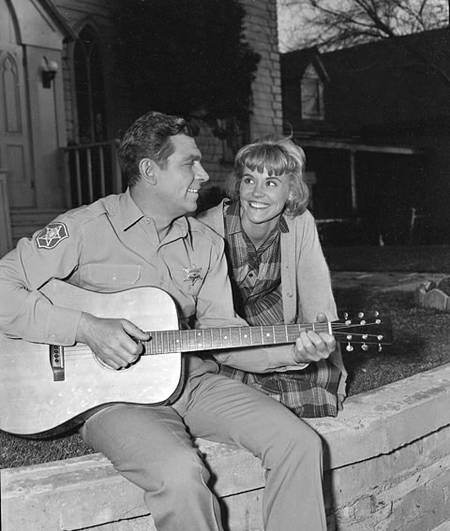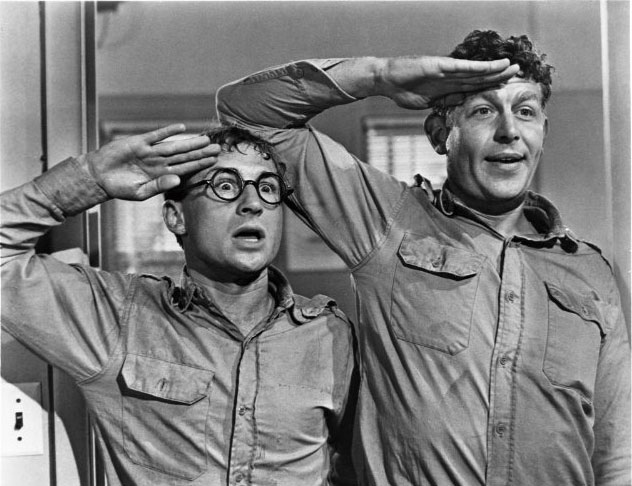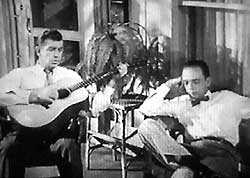He starred in a 1955 teleplay called No Time For Sargents. This play was made into a movie in 1958, which featured Andy playing the lead. It was quickly followed up with Griffith playing a similar bumbling country boy in the military in the movie Onionhead.
In 1957, producer-director Elia Kazan recruited Griffith to play the lead in his movie A Face In The Crowd as Larry (Lonesome) Rhodes, a hard drinking drifter plucked out of jail to sing on a local radio station. He is given his own television show and immediatly draws an audience based on his whit and simple country charm.
The film ends tragically. None-the-less it is a wonderful movie.
Andy began his beloved show by doing a guest appearance on The Danny Thomas show, in which he played Sheriff Andy Taylor, who cited Thomas for speeding through the small North Carolina town of Mayberry.
Both shows were produced by Sheldon Leonard and Leonard recognized Griffith would be right for a spin off show.
The Andy Griffith Show lasted from 1960-1968.
Many of the shows featured Andy sitting on the porch relaxing by playing his 1956 Martin D-18. At times he would play music with The Darling family, who were played by the well-known Bluegrass group, The Dillards.
In 2004 Martin Guitars came out with an Andy Griffith tribute model. What a beautiful guitar. The thing that puzzled me was the fact it looked nothing like the standard D-18 that Andy was known to play on the show. Aside from Mr. Griffith's signature on the neck, this guitar appeared not to have a pickguard.
 |
| Dick Boak |
The mystery was solved by Dick Boak, the historian for Martin Guitars, as well as an author. Boak states that he contacted Andy's management to see if he had an interest in endorsing a Martin signature guitar.
Griffith's management team said they would get back. Boak got a call from Griffith the very next day. It was then Andy gave Mr. Boak some history on the Martin guitars he owned.
Andy stated when he was making the film 'A Face in the Crowd,' the movie people needed two guitars. One was a cheap-looking one used by his character before he became famous, and a fancier one when he became the successful 'Lonesome Roads,'" Boak says. "The prop master solved the problem by taking a beautiful 1958 Martin D-18, and without consulting anyone, painted it black and gluing sequins on the guitars sound board. On the front of the guitar, the sequins spelled out Momma and Lonesome. Momma was a reference to the name Lonesome Rhodes gave to his guitar.
 |
| Andy with 1958 Martin |
He took the guitar to a guitar builder in New York City's lower east side to have the instrument given a new coat of lacquer and touch up to the wood. Ironically the guitar builder was non-other than John D'Angelico.
 |
| Brownie McGhee |
During Martin's 2004 run, they only produced 311 Andy Griffith Signature D-18's and then discontinued the guitar. They are gorgeous instruments.
Manufacturers suggest price was $3700 However used models can be purchased for between $2300 to $2500 and sometimes pop up on eBay.
Although the newer Martin guitar appears not to have a pickguard, there is a clear thin plastic guard plate below the sound hole. It is shaped in the old D-18 style. This is similar to the golpeadors used on Flamingo guitars.
The guitars top is made of solid bearclaw Sitka spruce. The back and sides are both fashioned from solid, quilted mahogany. The 14 fret low profile neck is made of select hardwood.
The solid headstock is carved in the1960's style and is capped with a piece of solid Brazillian rosewood with a decal of Martin's old style logo. The nut is made of solid bone. The guitar is bound with tortoise coloured binding around the body and on the endpiece.
The neck is dovetailed into a mahongany block. On the interior of the block the name Lonesome Rhodes is burnt into the wood.
The top inlay is multiple black/white. The braces are of course scalloped.
The guitars fretboard is made of solid black ebony wood and has a 24.4" scale. It is topped with 20 frets, 14 of which are clear of the guitars body. There is no fingerboard binding on this instrument.
The fretboard is 1-11/18th inches at the nut, tapering to 2-1/8 inches at the 12th fret. The fretboard comes with old style 18 mother of pearl position markers. The belly bridge material varies.
Some used solid Brazillian rosewood, while others came with ebony bridges. All had 16" radius bone saddles. The top is finished with aging toner and polished to a gloss. The back and sides are similarlly polished and have dark mahogany stain.
Tuning machines are Grover Deluxe Nickel done in the Kluson style. Martin recommends using medium guage strings.
Unique to this guitar is the paper label whiched is signed by Chris F Martin IV and Andy Griffith. Each label tells the sequence number. Andy's signature is inlaid on the 20th fret. This is not your average Martin D-18.
In retrospect, Griffith did use the non-pickguard D-18 in several episodes.
Griffith recorded several country and gospel albums as well as storytelling albums, and was inducted into the Country Gospel Hall of Fame in 1999, and in 2007 was inducted into the Christian Music Hall of Fame.
His greatest honor came on November 9, 2005, when President George W. Bush presented him with the Presidential Medal of Freedom, honoring his work and his timeless image, the way he came to personify a certain spirit of small town America.















Tidak ada komentar:
Posting Komentar